Today, I will show how to install python on Windows using Anaconda.
(step-by-step tutorial)
This post is part of the complete Guide on Python for SEO
No more headache trying to make Python work on your PC.
With this guide, you’ll have everything you need to install Anaconda and get started with Python.
If you are not so familiar with Python programming, I’ve built up a complete guide to help you Learn Python For SEO.
Let’s dive right in…
- Step #1. Download Anaconda
- Step #2: Download the Python 3 version for Windows
- Step #3: Double-click on the executable file
- Step #4: Click Next
- Step #5: Click I agree to the terms and conditions
- Step #6: Select Who You Want To Give Anaconda To
- Step #7: Select the installation location
- Step #8: Select the environment variables
- Step #9: Click Next and then “Finish”
- Step #10: See if Python Is Installed
- Bonus Step: Add Anaconda to Path
What is Anaconda?
Anaconda is a free and open-source distribution of Python and R programming languages for data science and machine learning.
This will help you simplify your Python deployment and later on your package management.
Anaconda comes with over a 1500 packages (including the package management system conda) and a GUI named Anaconda Navigator. The Anaconda Navigator also install some applications by default such as Jupyter Notebook, Spyder IDE and Rstudio (for R).
Installing Python without Anaconda
Installing Python without Anaconda is generally more recommended, unless you need all the packages that comes installed along with Anaconda.
I made these videos to help you install Python without Anaconda.
- Work with Python without installing it using Google Colab
- Install Python with MacOS
- Install Python with Windows
Download and Install Anaconda
Step #1: Go To Anaconda.com
Go to Anaconda.com, and download the Anaconda version for Windows.
Step #2: Download the Python 3 version for Windows.
Version 2 will not be updated past 2020, so do yourself a favor and start using V3.
Step #3: Double-click on the executable file.
To get the installation of Anaconda started on your operating system open the executable file in your Download folder.
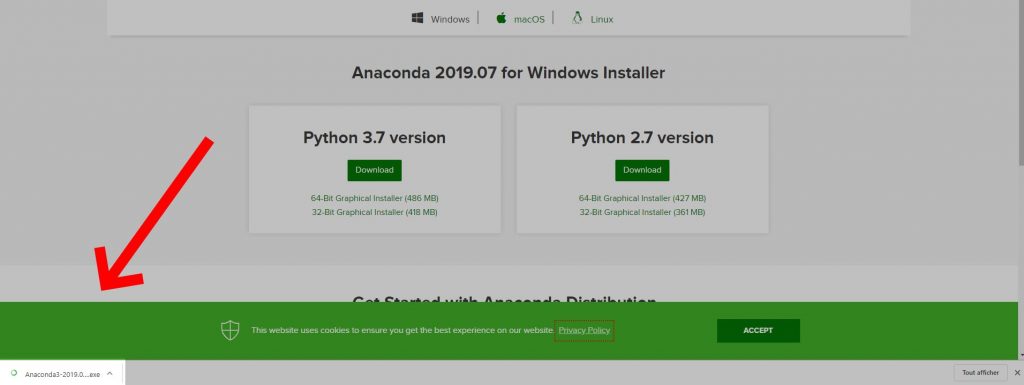
Step #4: Click Next
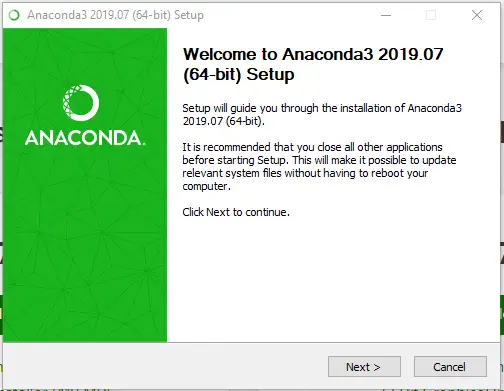
Step #5: Click I agree to the terms and conditions
Step #6: Select Who You Want To Give Anaconda To
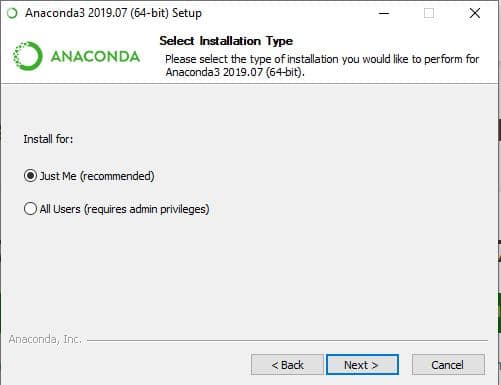
This step will ask you if you want to install Anaconda just for you or for all the users using this PC. Click “Just-Me”, or “All users”, depending on your preference. Both options will do but to select “all users” you will need admin privileges.
Step #7: Select the installation location
If you have selected “All users”, by default, Anaconda will get installed in the C:\ProgramData\Anaconda3 folder. So make sure that you have at least the right amount of space available to install the subdirectory comparing it the the space required.
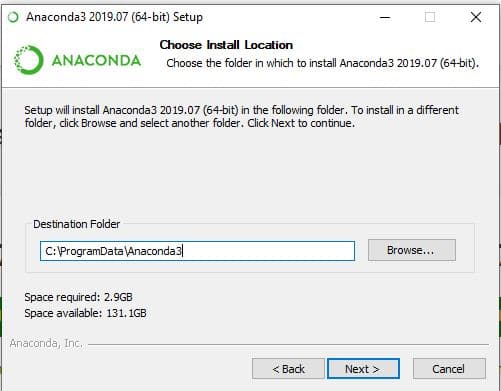
Step #8: Select the environment variables
Depending on if you have any version of Python already installed on your operating system, or not, to do different set-up.
If You Are Installing Python For The First Time
Check the Add Anaconda to my PATH environment variable. This will let you use Anaconda in your command prompt.
If You Already Have Python Installed
Leave Add Anaconda to my PATH environment variable unchecked.
Leaving it unchecked means that you will have to use Anaconda Command Prompt in order to use Anaconda.
So, unless you add the PATH later, you will not be able to use Python from your command prompt.
Python is not usually included by default on Windows, however we can check if any version exists on the system.
To know if you have Python Installed.
- Go to Start Menu and type “Command Prompt” to open it.
- Type the following command and hit the Enter key
“python --version” - If nothing happens, you don’t have Python installed. Otherwise, you will get this result.
$ python --version
Python 3.7.0
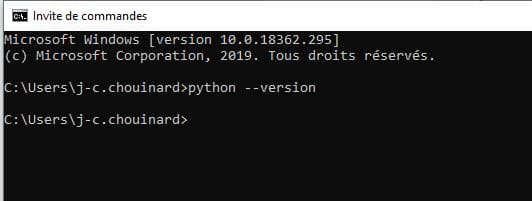
Step #9: Click Next and then “Finish”.
Step #10: See if Python Is Installed
If everything went right you can repeat the step 7 by opening your command prompt and enter “python --version”.
If everything is right, you’ll see this result.

Bonus Step: Add Anaconda to Path
You’ have left the Add Anaconda to my PATH environment variable unchecked and want to add it to your PATH? Here is what you need to do. By adding Anaconda to your Path, it’ll become possible to use Anaconda from your Command Prompt (or PowerShell, Cmdr, etc.).
Here is a great video by Michael Galarnyk to help you Add Anaconda to your Path.
This is it, you are now ready to use Python with Anaconda.

SEO Strategist at Tripadvisor, ex- Seek (Melbourne, Australia). Specialized in technical SEO. Writer in Python, Information Retrieval, SEO and machine learning. Guest author at SearchEngineJournal, SearchEngineLand and OnCrawl.